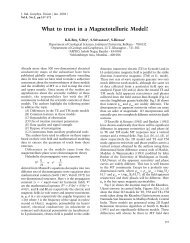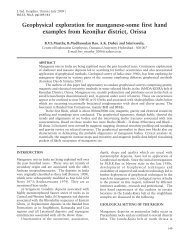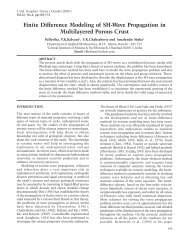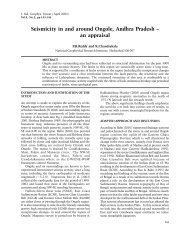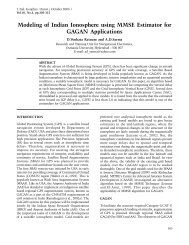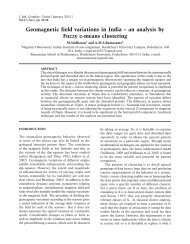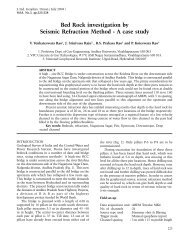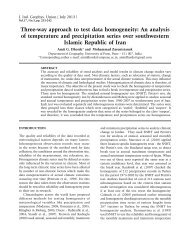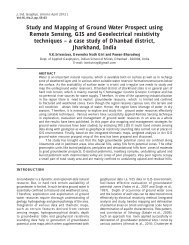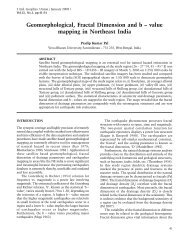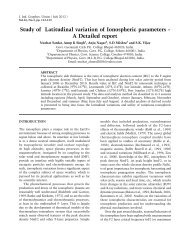U.S. De**, G. P. Singh* and D. M. Rase - IGU
U.S. De**, G. P. Singh* and D. M. Rase - IGU
U.S. De**, G. P. Singh* and D. M. Rase - IGU
Create successful ePaper yourself
Turn your PDF publications into a flip-book with our unique Google optimized e-Paper software.
U.S. De, G. P. Singh <strong>and</strong> D. M. <strong>Rase</strong><br />
between two stations. However, there is an increasing<br />
trend (Fig. 5) in the months of July at Alipur <strong>and</strong><br />
August for Dumdum. In Delhi, Safdarjung shows<br />
more number of events in August compared to<br />
Palam. Safdarjung shows an increasing trend in July<br />
<strong>and</strong> September <strong>and</strong> a decreasing trend in June <strong>and</strong><br />
August. Whereas, Palam shows an Increasing trend<br />
(Fig. 6) for June, July <strong>and</strong> September <strong>and</strong> a decreasing<br />
trend in August.<br />
Preventive <strong>and</strong> active measures:<br />
Urban flood management in developing countries<br />
requires an evaluation of socio-economic issues<br />
related to l<strong>and</strong> use <strong>and</strong> urban development in context<br />
to the frequent urban flooding (Tucci, 2004). Deaths<br />
due to natural hazards associated with floods are<br />
inevitable. However, impacts can be reduced by<br />
various measures, some of which are given below.<br />
a. Better forecasting of heavy rain over mega<br />
cities with the help of Doppler radars.<br />
b. Identification of vulnerable zones in <strong>and</strong><br />
around the mega cities against risk of<br />
floods <strong>and</strong> improved disaster management<br />
procedures.<br />
c. Improvement of old drainage systems, reenforcement<br />
of weak <strong>and</strong> old buildings <strong>and</strong><br />
introduction of area specific building codes.<br />
d. Implementation of health <strong>and</strong> sanitation<br />
measures to prevent spreading of diseases.<br />
e. Preparation of a long term plan aimed at<br />
diversification of industries <strong>and</strong> employment<br />
opportunities to prevent large scale migration<br />
of population <strong>and</strong> overcrowding of the mega<br />
cities.<br />
f. Greater awareness among the public for the<br />
weather warning <strong>and</strong> forecasts.<br />
g. Pollution control measures with planning of<br />
green cities, including urban reforestation.<br />
CONCLUSIONS<br />
Mechanism of urban flooding is very complex <strong>and</strong><br />
location specific. In the recent years due to global<br />
warming flash flood frequencies have increased<br />
creating havoc in urban cities.<br />
There are substantial spatial variations in extreme<br />
rainfall within <strong>and</strong> around Mega cities.<br />
In the period (1970-2006) it is observed that<br />
there is an increasing trend of very heavy rainfall<br />
(≥125mm) in Santacruz <strong>and</strong> over Colaba in<br />
Mumbai, Safdarjung <strong>and</strong> Palam airport in Delhi,<br />
Nungumbakkam <strong>and</strong> Minambakkam airport in<br />
Chennai, as all these observatories (Santacruz,<br />
Safdarjung, Nungambakkam) are located inside the<br />
city. There is, however, no significant trend for Alipur<br />
<strong>and</strong> Dumdum airports of Kolkata.<br />
The number of deaths due to floods is minimum<br />
in Delhi as it is an inl<strong>and</strong> station, as compared to<br />
other three Mega cities. The casualties are maximum<br />
in Mumbai. L<strong>and</strong>slides also cause increase in deaths<br />
<strong>and</strong> damage in Mumbai. Kolkata is very close to sea<br />
<strong>and</strong> is inside Ganges Delta plains. So, it is prone to<br />
flooding not only due to heavy rains but also due to<br />
tropical cyclones.<br />
ACKNOWLEDGEMENTS<br />
The authors are thankful to Dr. Jagadish Singh,<br />
Former Deputy Director General of Meteorology<br />
(Hydrology Division) <strong>and</strong> Deputy Director General of<br />
Meteorology (Training) for useful discussions.<br />
REFERENCES<br />
Bedritsky, A.I., 1999. The impact of weather <strong>and</strong> climate<br />
on economic development <strong>and</strong> sustainability, W.M.O.<br />
Bulletin, 48 (2), 175-181.<br />
De, U.S. <strong>and</strong> Sinha Ray, K.C., 2000. Weather <strong>and</strong> climate<br />
related impacts on health in Mega cities, WMO.<br />
Bulletin, 44, 4, 340-348.<br />
De, U.S. <strong>and</strong> Prakasa Rao G.S., 2004. Urban Climate<br />
Trends- The Indian scenario, J. Ind. Geophys.<br />
Union,(July 2004) Vol.8, No.3, pp. 199-203.<br />
De, U.S., Dube R.K., Prakasa Rao G.S., 2005. Extreme<br />
Weather Events over India in the last 100 years. J.<br />
Ind. Geophy. Union. Vol 9 No. 3, 173-188.<br />
De, U.S., G.P.S Rao, D.M.<strong>Rase</strong>., 2006, Deluge in Mumbai,<br />
WMO Bulletin, Vol.55, No.2, pp:126-128.<br />
Goswami, B.N, Venugopal V, Sengupta D. 2006. Increasing<br />
trend of extreme rain events over India in a warming<br />
environment. Science 314: 1442, DOI: 10.1126/<br />
science.1132027.<br />
Ghosh Subimal, Luniya Vishal, Gupta Anant., 2009.<br />
Trend analysis of Indian summer monsoon rainfall at<br />
different spatial scales. Atmospheric Science Letters<br />
10: 285-290, DOI: 10.1002/asi.235.<br />
Guhathakurta, P., Sreejith O.P., Menon P.A., 2011. Impact<br />
of climate change on extreme rainfall events <strong>and</strong> flood<br />
risk in India. J. of Earth System Sciences, Vol. 120,<br />
164



